Is it a fake 18650 battery? (Featuring the Samsung 25R) May 29 2015, 37 Comments

Table of Contents
Likelihood of fakesLikelihood of Fakes
Quickly knowing whether a battery is counterfeit is possible, here I'll show you how by taking a look at the Samsung 25R.
I picked the Samsung 25R because of its stellar reputation as a great high-amp cell. It finds use in electric cars, power-tools, vaporizers, and more and will almost certainly continue as one of the most popular 18650s at least until late 2015 when a newer generations could gain traction.
You might ask "Are the 25Rs even faked?" It was once thought unlikely because of their availability.
News Story: Houston woman gets a year for selling fake Samsung batteries
(April 2015) A 53 year old Mexican woman named Graciella Balderrama in Houston pleaded guilty and was sentenced to a year in prison for selling counterfeit Samsung batteries on Ebay. She’ll almost certainly be deported after her time in prison and has to pay $90,000 in restitution to Samsung SDI.
The court heard from a Samsung representative who clarified that Samsung takes pride in creating quality products. He noted that Samsung is very concerned anytime counterfeit goods, in breach of its own logo, are introduced to America. Of special concern is when these counterfeit products present a public safety threat like counterfeit lithium-ion batteries do.
And Balderrama participated in a conspiracy. Police have messages of her talking with her contact in China, where she acknowledges understanding the batteries were not genuine but consented to continue working.
Balderrama confessed to authorities she understood the batteries are not genuine Samsung batteries, but she continued to package and offer them as legitimate. Counterfeit lithium-ion batteries really are a public security concern since they cannot follow security regulations. Fake batteries can be dangerous and even explode. This is particularly a growing issue in China where the batteries are created.
Reported here.
So how likely is it that there are fake Samsung batteries on the market? Very likely indeed. Therefore it is vitally important consumers and suppliers are able to tell the difference.
Basic Inspection
Here are the official 25R specifications for your reference:

Using the 25R, let's start with a visual inspection
The first, easiest thing you can do is a visual inspection. Look at key features of your batteries and compare them to pictures on this blog post. For this blog post I used two 25R cells for each section so we can take a look at the differences between cells. They were bought from two different suppliers.
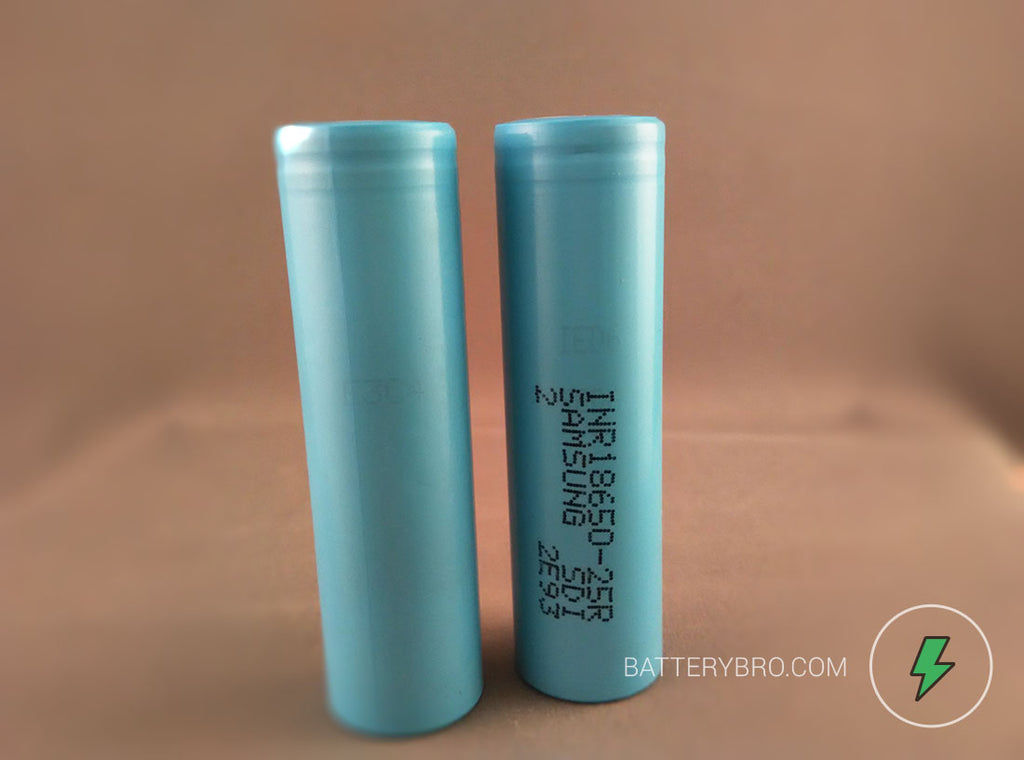
- Text printed on PVC reads: Line 1: INR18650-25R / Line 2: SAMSUNG SDI. / Line 3: (Different between cells) 2 2E93.
Here are two Samsung 25Rs side-by-side. Do your cells have any noticeable differences? Variations that are safe include slightly different hue for blue than picture (because of different lighting conditions), placement of any printed components (can be offset in both x and y planes). For example the text printed on the PVC is never aligned with the text printed below on the steel.
You may have noticed the text is actually made up of small circles. Counterfeiters may not take care to have exactly the same font and number of circles so sometimes I will count the top-most row of the text's circles and see if they match. It takes about 20 seconds to count, so for your reference, a genuine 25R has the following number of circles in its top row: [I:3, N:2, R:4, 1:1, 8:3, 6:2, 5:5, 0:3, 2:3, 5:5, R:4].
You should be able to see some kind of printed text on the steel under the blue PVC cover. If you look hard you can see an 'E3C4' in the center of the left battery in the image above. The right battery also has a code - see if you can find it. If your battery at home has no faded code underneath the PVC it is likely fake as I have never come across a 25R without them.

Take a close look at your top-caps (positive terminals) and the white washer - there should be no variation between this photo and your battery when looking at the top cap. Important: The Samsung 25R has a very circular positive terminal with three points of connection.

Take a look at the negative terminal of the battery. This is a normal amount of wear on a brand new battery, as the machines which move and test the batteries in the factory often leave scratch marks like these in the center. Beware of unusual amounts of wear and tear.
Make sure that the metal seen is a "silvery" steel color and not "golden" copper. Copper is used as the conductor for nearly all printed circuit boards, including those employed on protected batteries often found with flashlights. If you have a copper negative terminal you also likely have a protected battery that a 3rd party supplier added. You can confirm this by measuring the height of the battery - a protective board can add around 15 mm.
Keeping these contacts clean with a microfiber cloth will help prevent arching.
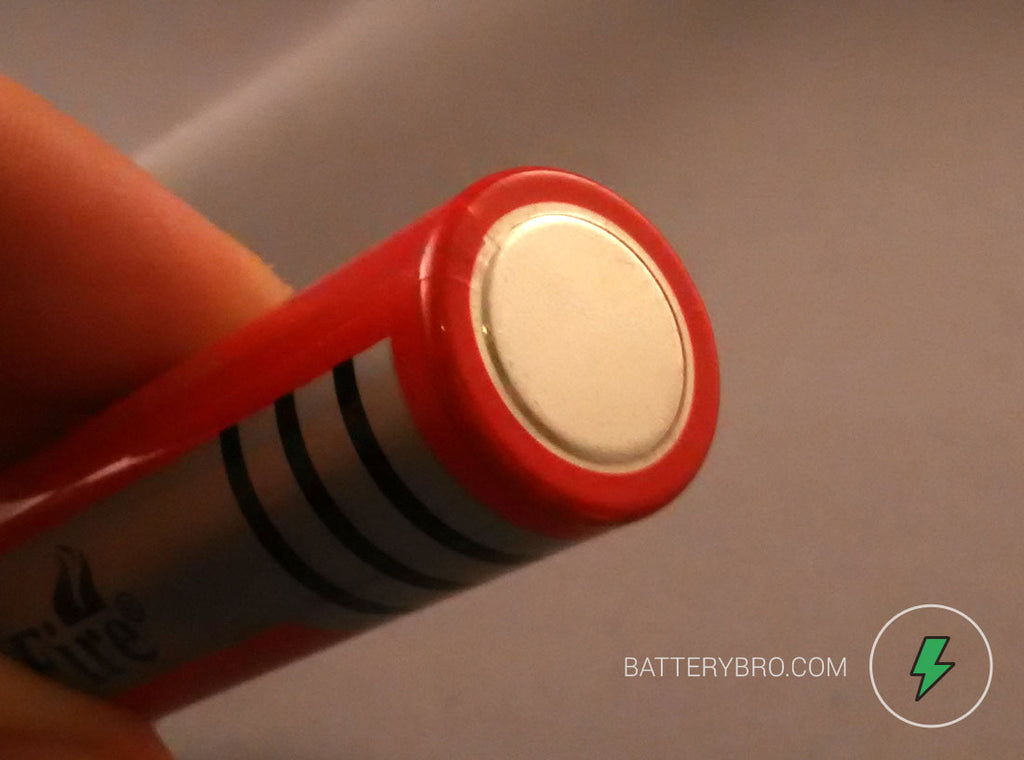
Besides copper negative terminals, you will also find outdented bottoms on re-wrapped batteries like this Ultrafire with an unknown metal. Original 18650 batteries do not have any protrusion and the 25R is completely flat.
Simple DIY Measurements
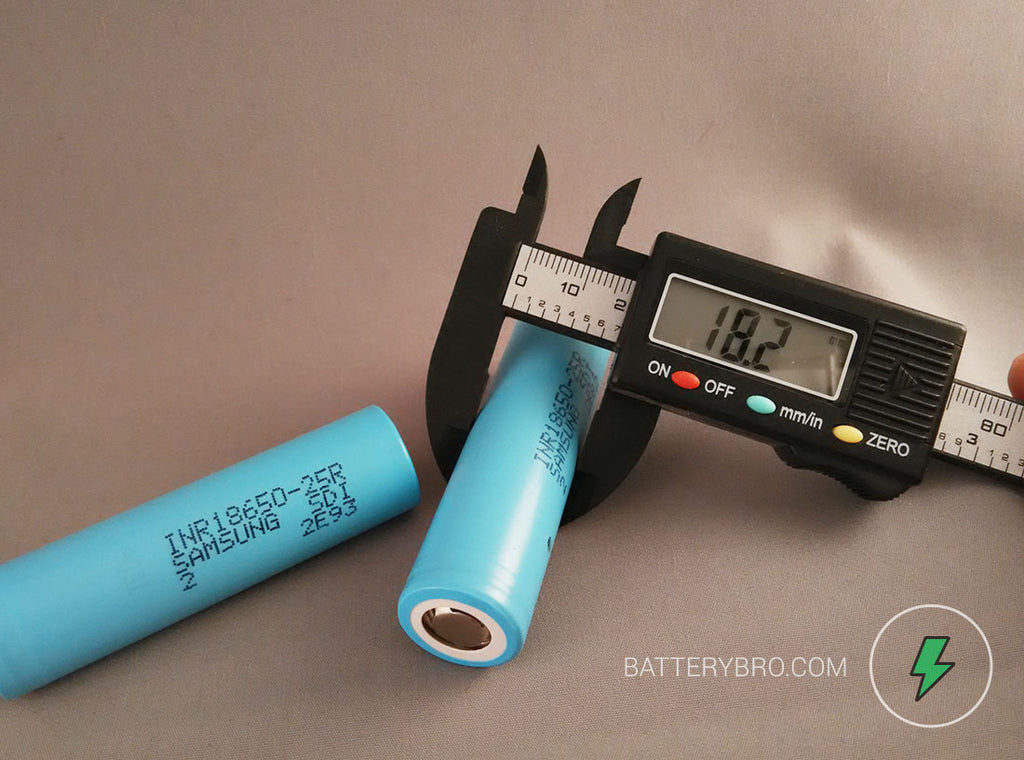
For these measurements, you will need some rudimentary tools, like digital calipers and a jewelry scale. So feel free to pass over this section if you don't have these things at your disposal.

Digital calipers are a cheap way to add an extra bit of evidence when determining authenticity of cells. Manufacturers release data that can be used to confirm authenticity - like the nominal specifications posted above. Width is not the most telling factor, as there is little variation in 18mm 65mm (18650) batteries. However, it takes a small moment so I'll have a quick check.
IMPORTANT: Do not use metal calipers without putting some electrical tape or other insulator over the ends. I don't use metal-tipped calipers. If you connect the positive terminal and negative terminal with anything that conducts, you can short-circuit your battery.
The width should be between 18.26 mm and 18.40 mm. My calipers only have an accuracy of .20 mm, the measurement I took was 18.20 mm, so the actual width of my battery matches the nominal size in the manufacturer's specifications.

Checking out the length, there is more variation here between different batteries. My measurement comes out to 65.30 mm, with a .20 mm error. Nominal specifications require 64.85 mm with a 0.15 mm error. The total error is .35, so my measurement actually falls short by .10 mm even accounting for the error. After realizing this I went back and took the measurements again and made sure to zero the calipers. My actual length measurements now match the nominal manufacturer specifications and everything is fine.

I put a dot on the battery so I don't mix them up. This is what the first battery weights in at - 43.63 grams.The nominal specs say the 25R should be 45.0g max and nothing else. So the first cell checks out fine.

Here is the weight of the second battery, with nearly no variation from the first it also checks out fine at less than than maximum 45.0g allowed.
Getting naked, taking off the PVC heat-shrink
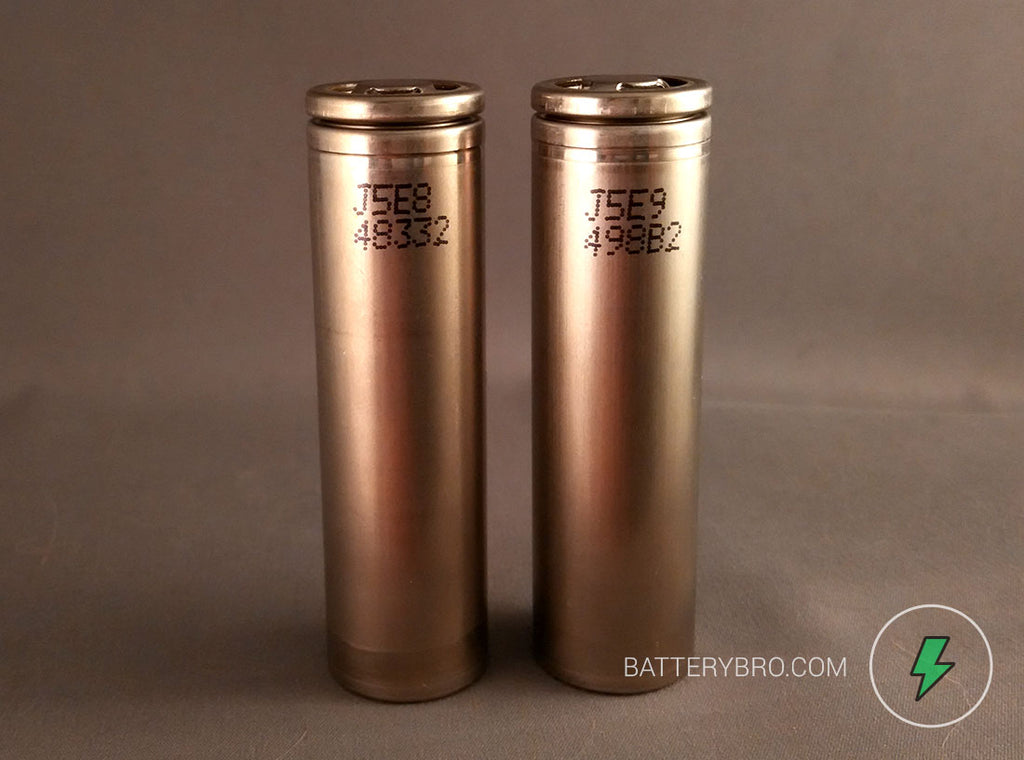
Markings part one. These markings "J5E8, 48332" and "J5E9, 498B2" can be found one one side of the battery near the top-cap.

When I spin the batteries around I get more markings. Written here is "E3C4" and "IED6, IED6".
Now I don't expect your Samsung 25R batteries to match exactly, but if they have these two types of markings on either side it is a nice piece of evidence to add that your batteries are genuine and not fake. I am not sure why the right battery has its code printed twice or that it appears to be darker, but these two factors play no role in determining authenticity apparantly (as each cell was later tested and confirmed to be genuine).

This is the vent of your battery - it spews bad stuff when the battery overheats to relieve pressure. Something mildly interesting about the Samsung 25R is that is has quality control markings right next to the vent, and most batteries do not. Pictured above is a good viewing angle to check out your battery's vent.

If you get the lighting and angle just right you can actually see the etching marked into the 25R battery near its vent. The other 25R also had a one letter + one number combination. A magnifying glass makes this much easier to do and it can be challenging to find the code especially without removing the white washer and PVC.
I looked at other cells from various manufacturers like the LG HE2 to see if they also have markings near the vent. They do not, and my small search indicates it might be a unique marking to the 25R. So this is a fairly straightforward way to verify your battery as a 25R.

Here is a better look at the battery top-caps with their PVC and washer removed. Aren't they pretty?

Now this is an interesting feature! Both Samsung 25Rs that I'm testing, once the PVC is removed, are revealed to have a tiny '0' marked into them. As none of the other 18650's I've tested have this marker - it may be an excellent way to quickly identify a genuine 25R from a fake.

A closer look at the symbol, with some "enhancement" so you don't have to squint. The cross through the circle designates a zero. I do not know if all Samsung 25R cells have this mark, but the two that I tested for this blog post do. You will have to peel back the PVC on the bottom-rim of your battery to do this test. While there is likely little danger in doing this - it is best to completely replace your battery wrap with a new heat-shrink tube afterwards.
I am interested to hear if others also have this 0 marked into the rim of their negative terminal. If you do, please send us a picture or a comment and I'll attach it to this blog post.

I needed to check that other brands of batteries and other Samsung batteries do not also have this zero etched into them. They do not, and it seems to be a unique characteristic of the Samsung 25R.
Stickers on your battery?
Note that many lithium-ion batteries have a separate sticker on each cell which states the cell’s size, voltage, and capacity. International shipping rules mandated by the United Nations require this information for each cell when shipped via air freight (note: this is not necessary for sea shipping.) Suppliers will print batteries or tape a piece of paper with this information and stick it to the battery. It does not mean the batteries are fake, just that they were shipped via air freight from Asia and the suppliers needed a simple way to comply with the rules.
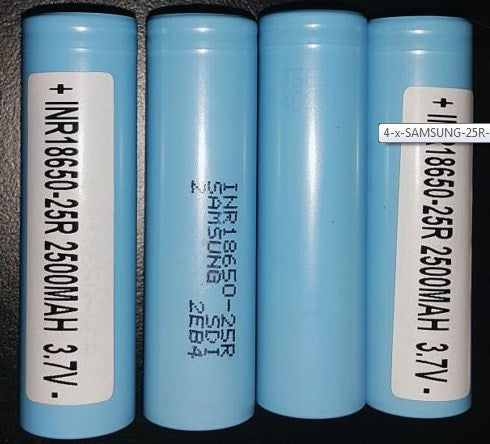
Here is an example of a couple 25Rs with shipping stickers on them. I found this image on Ebay; you can deduce that the supplier had them shipped via a cargo plane (because ships don't require the stickers). You can also deduce the supplier bought less than 10,000 cells as this is around the number where shipping by sea becomes necessary.
Other things worth checking out
Top-cap Identification (Top-cap ID Method)
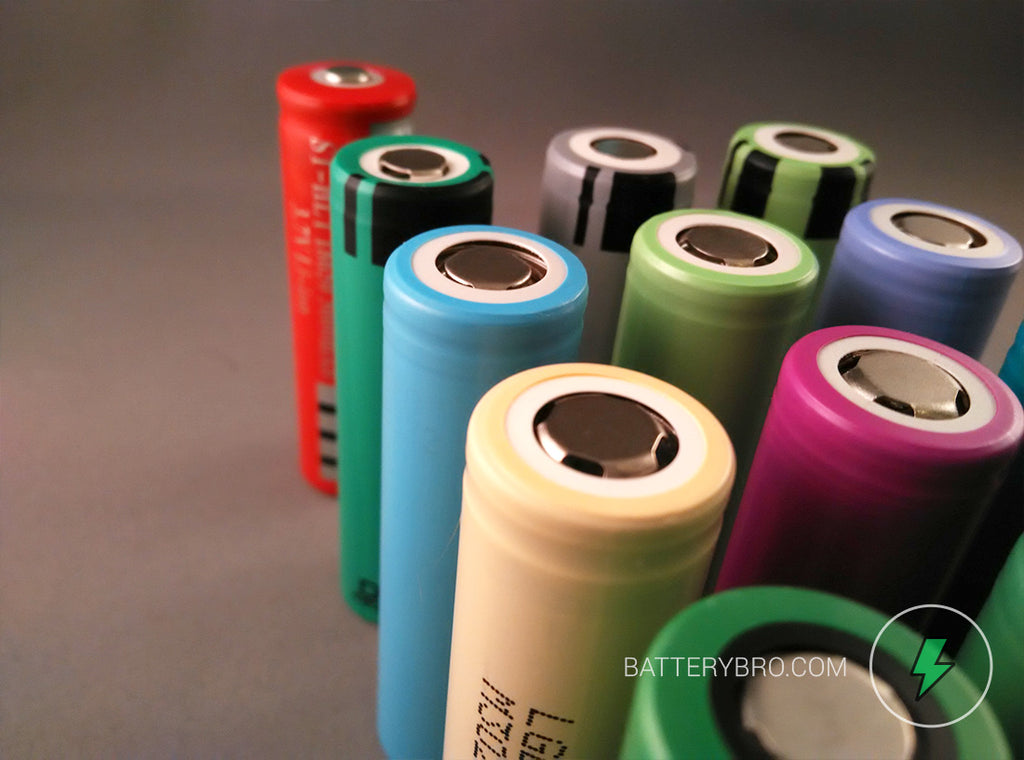
You may have never noticed, but each brand of 18650 has their own specific top-cap which is very difficult to counterfeit. A counterfeiter would need a very cheap way to completely take the battery apart, and put it together again with a low (undetectable) amount of damage. In my experience, this just doesn't happen and is too difficult. Therefor it is possible to ID an 18650's manufacturer just by glancing at its top cap.
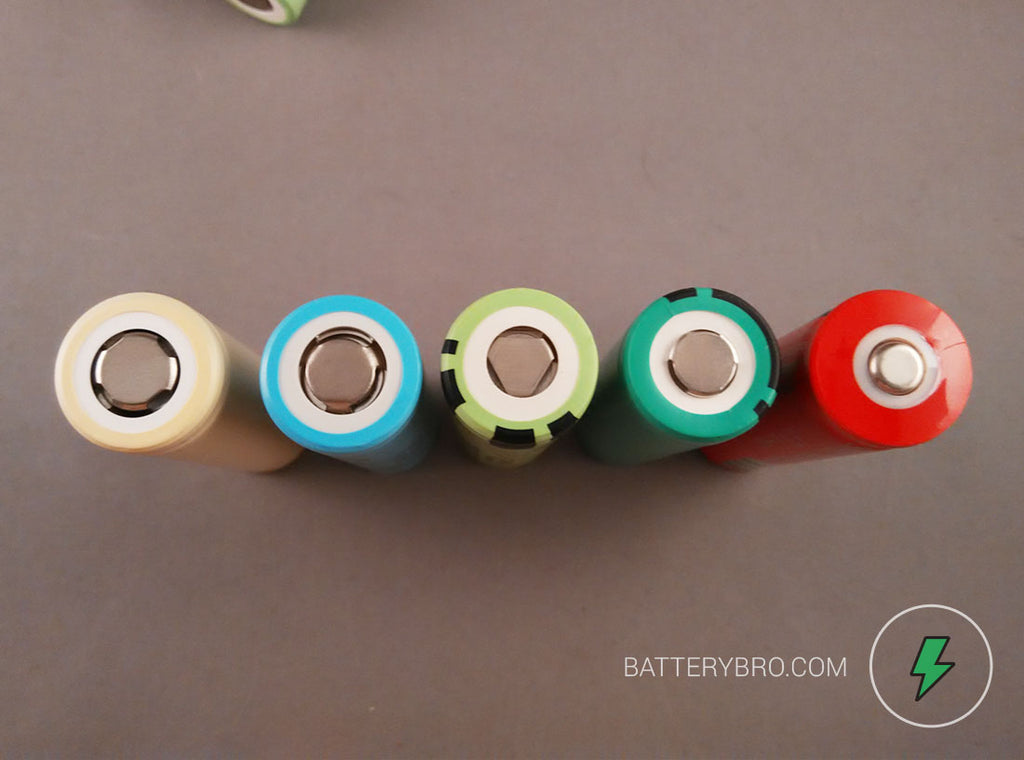
The lithium-ion battery manufacturers like Samsung, Panasonic, LG, patent absolutely every new idea they have. Licensing technology like the NCR chemistry or other parts of a battery is very profitable so intellectual property protection is important.
It is for this case I suspect each brand of battery has their own particular style of top cap. I do not believe there is any real advantage to any of the designs, and a consumer will never notice a difference. That is, unless they’d like to identify the battery’s brand.
I took about ten batteries of each brand and put them all together in groups to see if I could notice a difference. The difference was obvious immediately, and held up for each group of batteries. So this is a very quick and easy method to see which brand a battery is.

View this image larger on Imgur: http://imgur.com/4gnFl7m
Cells made by LG Chem have four connection points between the positive terminal and body of the top cap. Samsung cells have three. Panasonic cells have more variation and both triangles and three-point contacts were found. As well, many suppliers re-wrap these cells and add a button-top which is seen last. There is also variation in shape of the positive terminal excluding the connection points between being round, straight, or a combination of both.
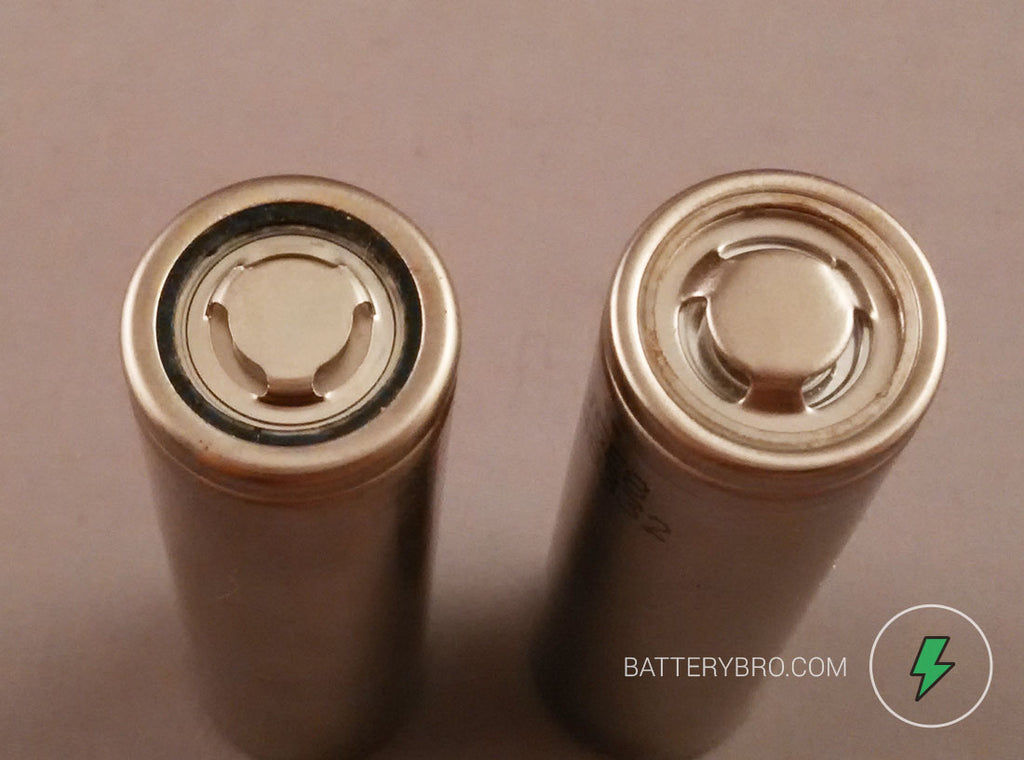
Maybe you noticed the Samsung and one variation of Panasonic positive terminal were very similar compared to the others. Can you tell the difference between them in the picture above? The correct answer is that the right battery is the Samsung. Check out the small differences, the most notable probably being the dark ring around the circumference of the Panasonic, where the Samsung does not appear to have any such ring. The Panasonic also seems to have a flatter surface near its vent.
Difference between washers
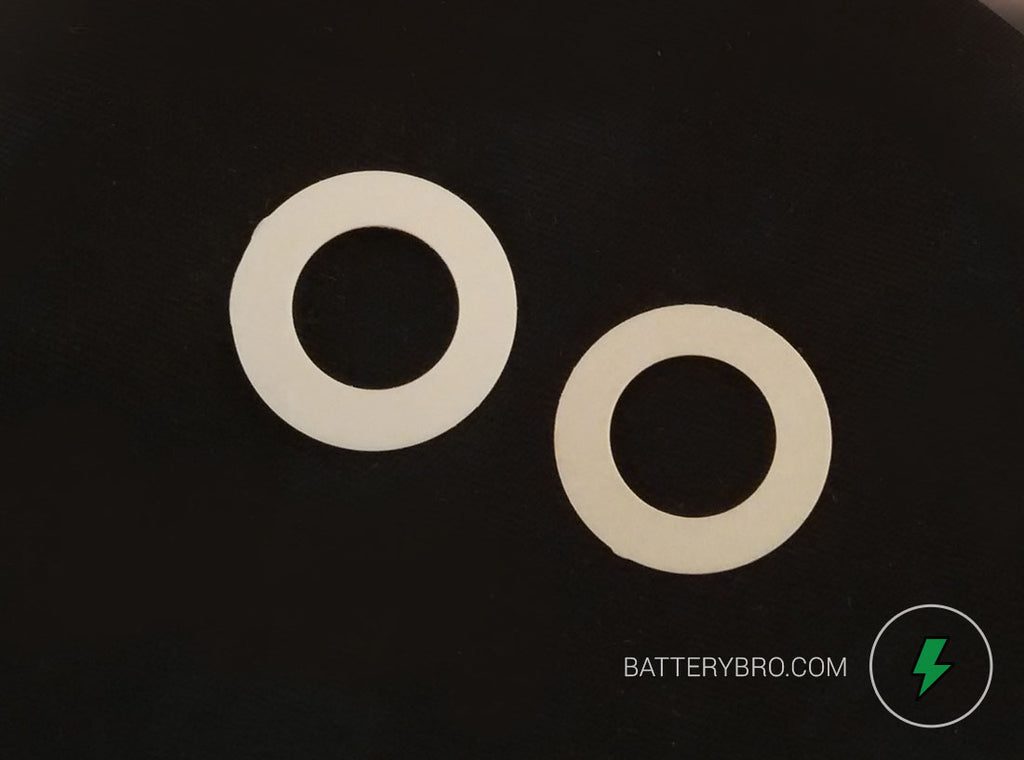
Washers are probably not something you are very interested in. But it adds another piece of reliable evidence to the authentication process. Counterfeiters have a very difficult time being so thorough so it is our edge to have a more complete picture than them.
It is probably true, because of patents, that the washers between manufacturers are also different. I've taken an LG HE2 and Samsung 25R washer for comparison above. With the naked eye and discernment of my fingers it was much easier to distinguish differences... the photo does not do a great job at showing the differences.
The left washer is the Samsung 25R - it is brighter, more brittle, and smoother with a glossy finished surface. The LG HE2 washer is slightly browner, without a glossy finish, and is much more elastic and less brittle. The 25R will resist well against bending, and the LG HE2's washer bends easily like paper. The 25R washer can be pulled apart and snapped quite easily, while the LG washer stretches and is harder to snap apart.
There might be advantages to different washers at high-heat and how they react and help stop thermal-runaway events. But I think that's really a stretch and likely one does not have any benefit over another. However it is another indicator of authenticity that can be corroborated with the others.

Let's just measure them before moving on. The hole is about 9 mm in diameter. The 25R's ring is .30 mm thicker than the LG HE2's.
Taking a look at batteries under a blacklight
Black lights are pretty cheap and small key-chain lights for identifying fake currency are easy to buy. So half-way while writing this blog post I realized the opportunity and took a walk and bought one. Let’s see if there are any peculiarities while putting a line-up of 18650 batteries under the black light.
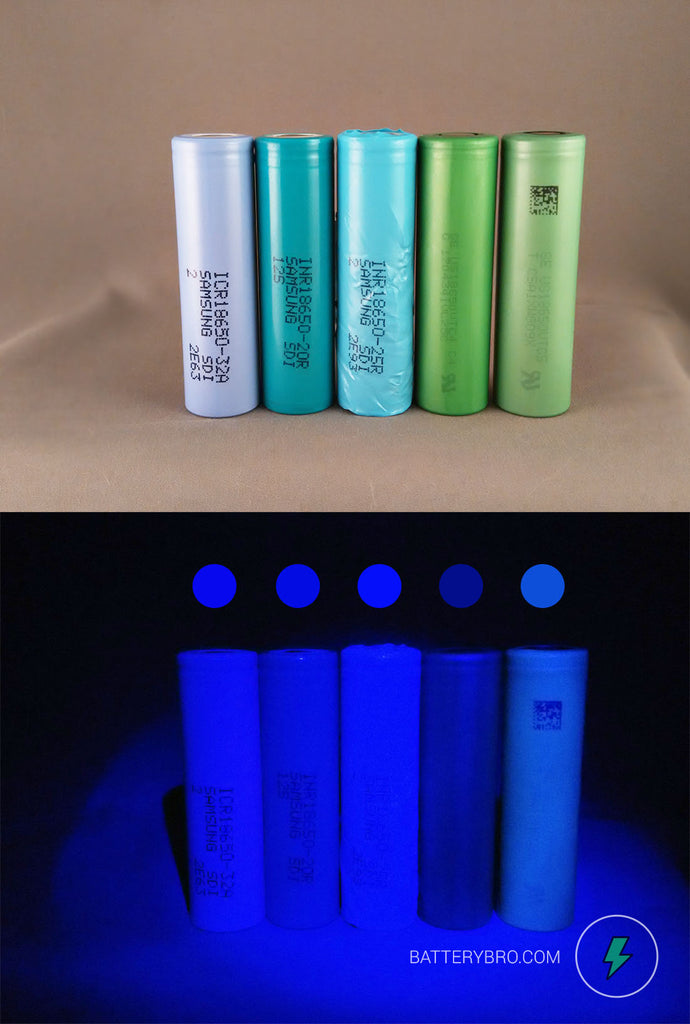
Note: The 25R wrapper is not on tightly, as I took this picture after I had already deconstructed the battery somewhat.
The 25R glows brightly when under blacklight, at about the same level of intensity as the other two Samsung batteries. From this I may conclude that Samsung batteries show brightly under blacklight. I can not say exactly how bright without equipment I do not have - but I can compare them to some fake VTC series batteries I was sent as samples from a Chinese supplier. What is interesting is that the fake batteries show a much less saturated reflection of the blacklight, indicating a difference in the chemical composition of the PVC.
If you have a little blacklight key-chain you can check your Samsung 25R PVC. It should be fairly bright, if it gets darker under blacklight it is indicative of a counterfeit cell.
Defects and visual signs of wear and tear
Here are some other ways you can quickly see whether your battery is new or used. There are some obvious defects that a manufacturer would never allow to be sold off to a reputable dealer. If your “new” batteries show any of these signs of wear and tear you have likely purchased used batteries.
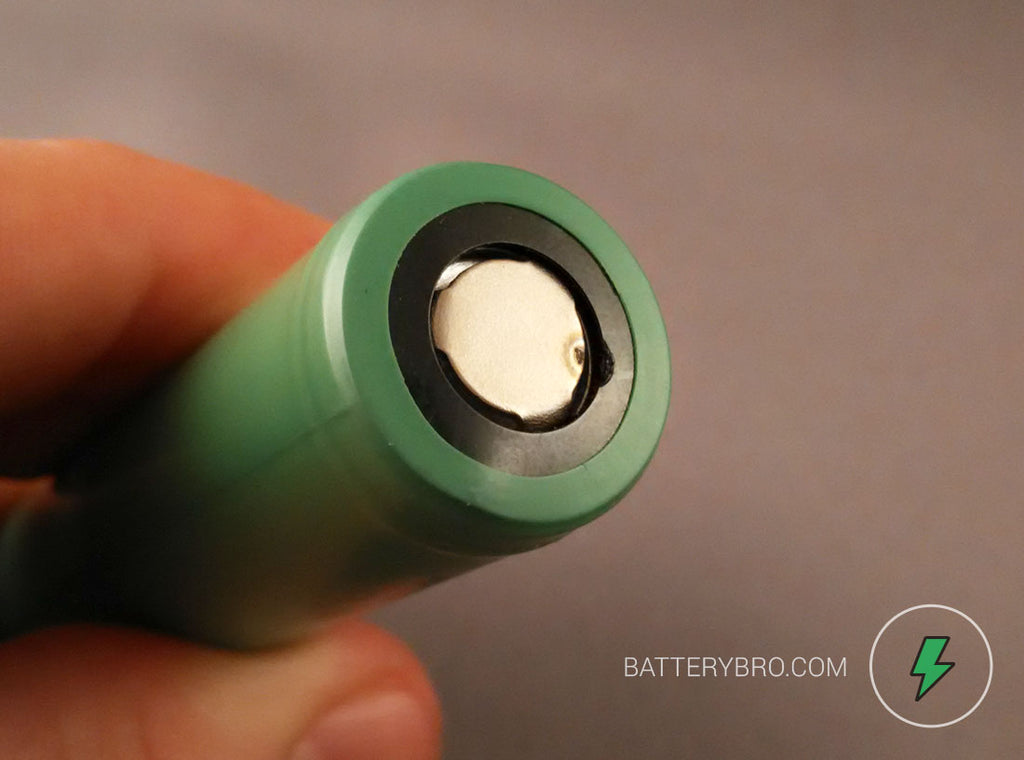
The Burn Mark. This battery came with a burn mark that must have been very hot to both scorch the steel and burn away the plastic washer. It was being sold as a new VTC5 but is certainly not. This battery should be recycled.

The rust spots. What is rust doing on your batteries? This is bad news and indicative of a really old battery. Again, this cell was being sold as a new VTC5. If your battery is rusting like this when you buy it, it should be put directly in a nearby recycling bin.

Large amount of bottom scratches. This photo did not do the scratches justice. The entire negative cell was very scratched, in many direction and with scratches reaching the rim of the battery. This is far more damage than the regular wear and tear from a manufacturer's assembly line. This battery was also being sold as a new Sony VTC5 - but is obviously not.
Samsung 25R discharge tests and voltage noise

Ok so discharge tests are not easy, or quick at all to do and is an exception to the title of this blog post. However I wanted to show you discharge tests quickly to show you what a good clean discharge looks like, and what a dirty discharge looks like. First I charge each battery up to 4.2V with this charger. You can see over 2500 mAh is now held by the battery.

I then use this custom Arduino battery discharge with an 18650 adapter. I have taken countless Samsung 25R discharge tests. I have recorded all kinds of discharge curves and want to give you a quick sense of the curve so you may appreciate voltage symptoms in low-quality or counterfeit 25Rs.

This is what a normal, brand new cell's discharge looks like. It is not as flat as a high-capacity cell but it is a very flat curve (lithium-ion) for batteries nonetheless.

This is the discharge curve from a Samsung 25R too, but notice the two small blips in voltage. This is indicative of a lower quality cell.

The third is the worst. And this is also the curve of a 25R, albeit with large amount of noise and excessive voltage swings. These voltage dips also caused the final capacity to drop by 100 mAh compared to other tests. If you notice a lot of voltage jumping your battery may be discharging in a similar way.
Summary
Identifying fake batteries (like the Samsung 25R) quickly and easily
As this post is so large, it only makes sense to break it down with some take-away points if you skipped all the details:
- Compare your batteries with pictures on this website
- Measure and weigh the batteries, compare to spec sheet
- Look for faded codes under the PVC
- Look for a two digit code near your 25R's vent
- Peel back the PVC on the rim of the neg terminal and find the '0'
- Use a blacklight and look for a bright reflection
- Look for unusual wear and tear like burns, rust, or excessive scratches
- Look at the top cap, and compare it to the diagram above (shape, connections)
- Look at the negative terminal, make sure it is flat and steel
- Take the PVC off, confirm there are quality control markings
- Take PVC off, and compare washer description with one given above
- Monitor voltage while discharging battery and look for spikes, or jumpy voltage readings
Thanks for reading! Any questions or comments please let me know below.

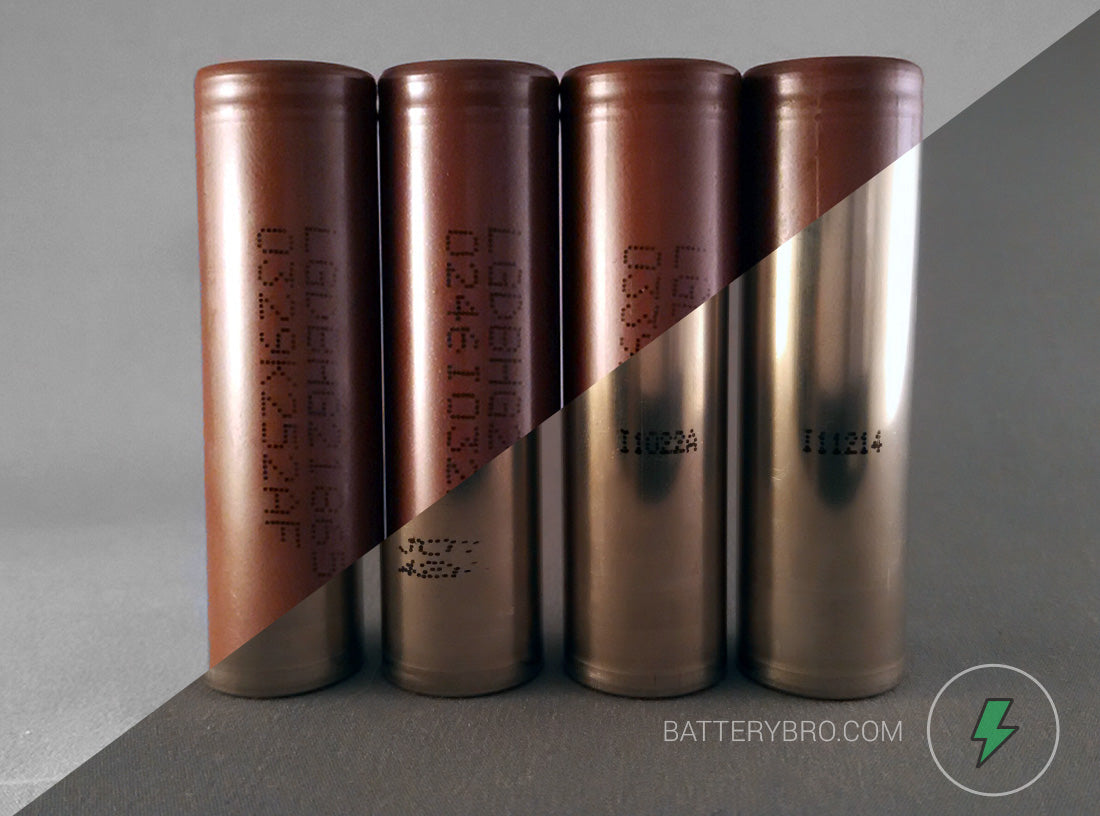
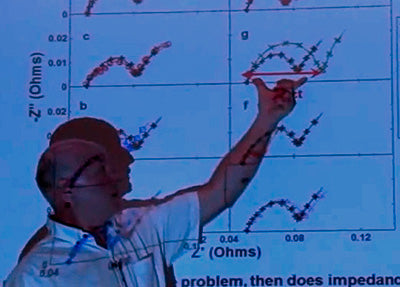
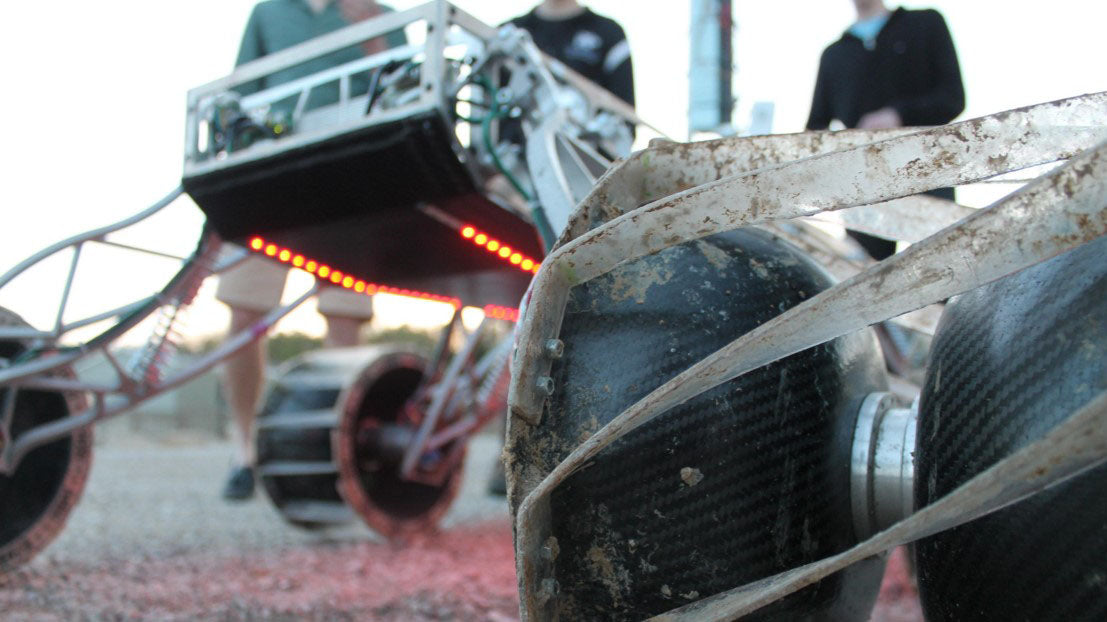


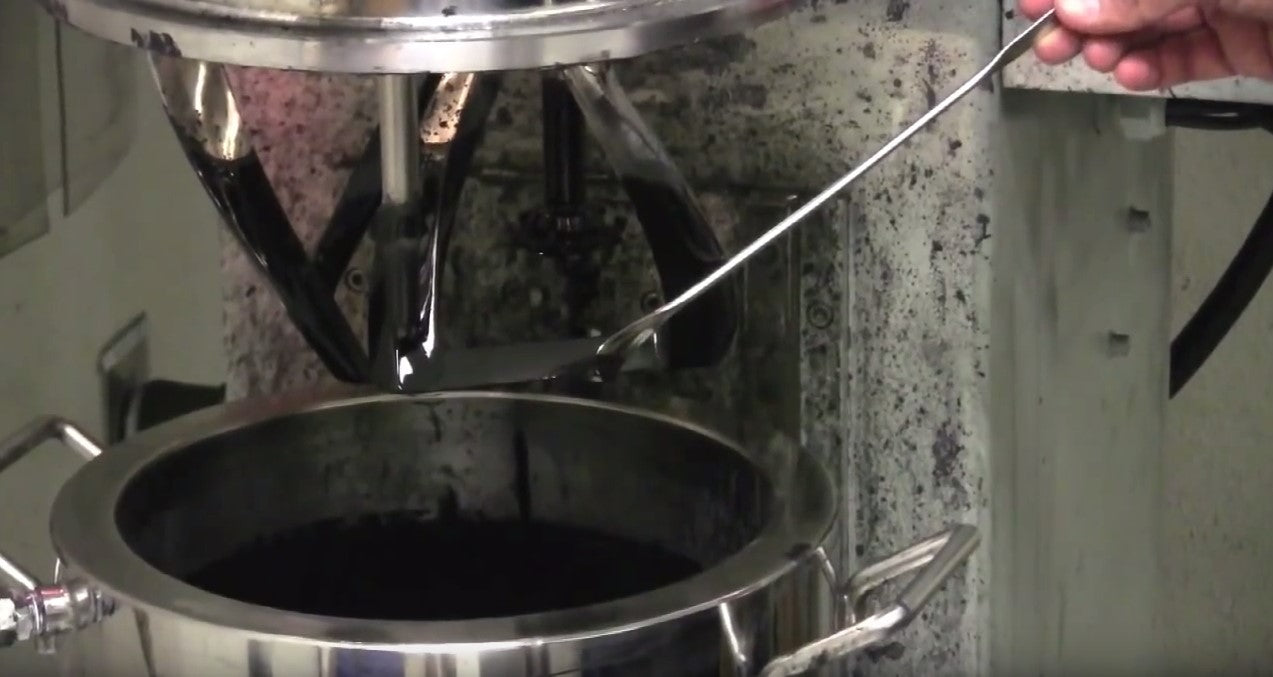
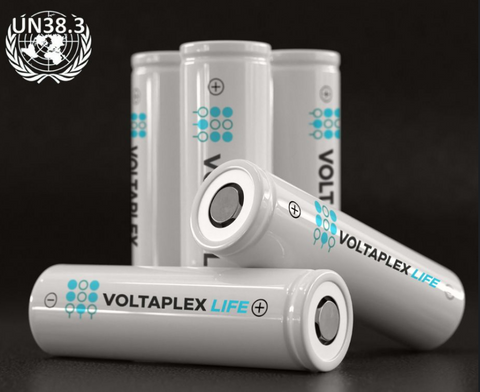
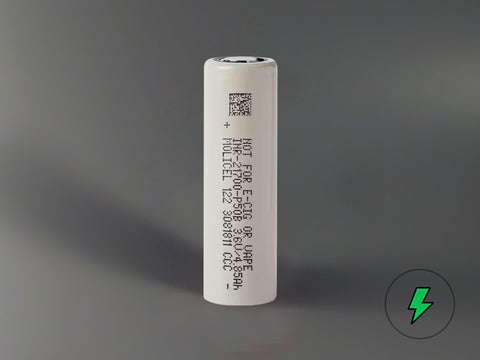
Comments
Eddy on August 17 2020 at 11:41AM
Very informative article.
I recently bought some of these batteries on ebay and the ones I received have some differences in text and font.
Line 1: INR18650-25R M / Line 2: SAMSUNG SDIEM / Line 3: 5 TIZ1
The font is different from your pictures. For your reference, in the same top row, mine have the following number of circles: [I:5, N:2, R:4, 1:1, 8:3, 6:3, 5:5, 0:2, 2:3, 5:5, R:4, M:2].
It seems Samsung manufactures the 25R in both Korea and Malaysia and Malaysian cells are marked SDIEM (Samsung SDI Energy Malaysia).
They should perform the same as those marked SAMSUNG SDI but I can only hope the ones I received are genuine because I won’t be able to record discharge curves.
I can send you a picture if you want.
Jim on August 17 2020 at 11:40AM
Nice job. Thank you for the time and effort to put together this great info.
Asif on August 17 2020 at 11:35AM
I wonder what is the meaning for the 3rd row code? I saw some 5 6..then last 4 letters in 3rd row also varies..1st n 2nd row same..but 3rd row varies.
Dopy on August 14 2019 at 01:13AM
Just to FYI I found my batteries to be correct other then some slightly different markings then yours and 3 dots on the 6. I did not do the black light or discharge test.
Mitch on June 01 2019 at 05:43AM
Go Luke!! 👍
Great catch and I’m still chuckling.
Darrell on October 16 2018 at 05:06AM
Hello, Guys!
I’m curious, who manufactures “Westinghouse” 18650 2000 mAh Battery’s ?
Thanks A Bunch!
Larry on February 02 2018 at 02:05AM
Thank you for this in depth guide. I paid 8 dollars for a 25R from an actual smoke shop in town and was confused when it consistently died in less than an hour. Sure enough it has four connectors on top instead of three, the 6 has one to many dots and there are no markings underneath the shrink wrap. I’ve never encountered such wide spread counterfeiting of a product in America before and it scares me.
Luke on September 26 2017 at 05:36PM
I suppose that ‘IED’ code on the cell explains some od the Galaxy Note 7 problems :)
James on June 26 2017 at 08:28PM
You Wrote: “You can see over 2500 mAh is now held by the battery.”
Wrong ! wrong! wrong!
This 2500mah charger figure is just an internal calculation based on the current draw from the cell being charged.
It doesn’t guarantee by any means that the cell has retained all of this or even any of this energy.
The proof of the pudding can only be found in the cell’s discharge data.
gridflash on January 26 2017 at 02:06PM
One other test that was not noted here; Rollover test.
A lot of the fakes have a smaller battery inside the shell with the obligatory fake wrapper on the outside. It turns out that it is difficult to center that small battery within the 18650 shell. What this means is that the fake battery will tend to roll over when placed on a flat surface; seeking the center of gravity. None of the real 18650s seem to do this since the winding around the core is properly centered.
Graham on December 02 2016 at 07:56PM
Do the 25R5 have the same number of dots on INR etc? I have 3 and 2 are clearly different from the other, only 1 has the number of dots stated here and other 2 have a different font then these.
Frank on October 11 2016 at 12:00PM
Great post, the article is right on point, nice images on the blog. Thanks for sharing. Samsung Tv in Ghana
jason merkel on August 27 2016 at 08:14PM
I got a couple of free power banks with 2600mah inr18650 in each and they have no company markings and five connections on the positive end instead of three and I am wondering if they are good?
doyen on August 09 2016 at 04:33AM
I bought 6 batteries from supplier as per your recommended visual and weights ,everything is ok till I put in charger ,first charge burn second charge also burn !! weight ,mark all is ok ,is there any test I can do ? reading of multimeter is 3.9V .
Jerry Oldaker on May 11 2016 at 02:30AM
My 25R’s have just an H near the vent hole, not an H4 like the pictures. What do you think? Fake?
YD on April 30 2016 at 10:12AM
I think you should update your EB device,because the accuracy of EBD-M02 is only 0.01v/0.01A and the max amps of it is only 2.5A.
I suggest you choose EBD-A05.The accuracy is 0.003V and the max amp is 5.0A.
And the YR1030 is good .YR1030 is a DIY 1khz AC battery resistance meter,the accuracy of it is 0.01mΩ.It is very popular in China.
steve on April 27 2016 at 06:10AM
Please post your arduino design and code.
Let loose an army of testers to crush dishonest/ignorant stores.
Is there a similar RPi design?
Billy Boyle on March 22 2016 at 05:53AM
Thanks for putting this together for everyone a very interesting and informative read.
Johnboy on January 25 2016 at 08:09PM
This page is awesome. I bought 2 real 25r batteries a while back. Now I’ve just purchased 2 25r that are clearly fake. 4 connections and no marking on the bottom. Wrapper is the wrong color and opaque too.
So I’m ordering LG HG2 and I realize that I have no way to tell authenticity. Please please make some more guides on fake spotting. Our lives depend on it.
Robin on January 10 2016 at 09:13AM
Like John & Barry I also got an vaporizer (S.T.O.R.M.) and I am in search of a higher capacity battery.
@ John & Barry: Do you have the same device as I do? What is your experience with using other batteries than the supplied on?
@ Anton: Is there a difference between 18650 batteries? Like INR18650 & ICR18650 and the different codes on 3th line of the battery? Like John I am interested in using a higher mah battery but not sure if it will damage my device.
Marcus on January 02 2016 at 05:04PM
Thank you for the excellent information! I found your site thanks to Pegasus Vapor Academy’s channel, and am thankfully relieved that both my LG HE4’s and Samsung 25R’s are genuine! I appreciate all the time and research that goes into your blogs, as well as other experienced vape enthusiasts that share their findings to help the rest of us!
Great job!
Joe on December 11 2015 at 04:27PM
Is there a reliable vendor from which to buy authentic batteries? Who would you recommend?
John on December 02 2015 at 04:52PM
Thanks for all the time you’ve taken to create this great blog. I’ve learned a lot. I have a question regarding a Samsung labeling discrepancy. I’ve tried without luck to find an answer, so thought I’d ask here.
I just purchased a Samsung INR18650-25R battery (green PVC wrap) at my local vape brick and mortar for use in my personal vaporizer. The battery was packaged in a Samsung cardboard sleeve which lists 4 model numbers, all of which begin “ICR18650” as opposed to INR18650. There’s a checkmark next to model number ICR18650-25R.
As far as I can tell, the battery inside the box, which has an INR18650-25R label inked on it, does not appear to be fake. However, I don’t have calipers or a scale so I’m basing that on the visual cues you identified in this post.
I called my vape shop and nobody could explain why the box says “ICR18650” whereas the actual battery is labeled “INR18650.” They referred me to their warehouse, but nobody at the warehouse has returned my call.
I think I know the answer to this question but I’ll ask anyway: is this battery safe to use in a personal vaporizer, or should I assume it’s a fake and/or an ICR battery?
Aaron Eccles on November 05 2015 at 10:27AM
All 4 of my Samsung 25R have ‘12’ engraved on the negative terminal and ‘H4’ underneath the positive terminal.
Thank you for such an in depth, well written and factual post. Made an excellent read and helped me greatly.
Ken on October 08 2015 at 03:53AM
Thank you for taking the time and effort to put this well crafted piece of writing together. Very detailed, looking at all the possible elements that can be inspected and checked, much appreciated.
Adam on October 01 2015 at 05:42PM
I just purchased 2 Samsung 25r’s from
a fairly new vape shop (2 weeks.) And my positive end has 4 connections, not 3. And i cant see any faded markings under my blue wrap. Should i be concerned?
Anton on September 25 2015 at 03:18AM
@Greg – Unfortunately I’m not aware of these units being sold outside of domestic China or Hong Kong.
@Barry – Yes your batteries do sound authentic. Since this blog post I’ve received messages that authentic 25R batteries have other characters such as you mention. The etching remains on the bottom but the characters are different.
Barry on September 24 2015 at 11:50AM
Thanks for such an in depth article!
I have recently started Vaping and I’m using the Samsung 25R batteries which I bought from my local vape store who only sells genuine/authentic items. I was very glad when I found your article. I checked all 4 batteries removed the shrink wrap everything checks out as per your information; except 2 batteries had ‘0’ (zero with slash) on the bottom the other 2 batteries had a capital ‘B’ and not ‘0’ (zero with slash).
I bought 2 from a Banggood.com I asked them before buying if they were genuine/authentic Samsung 25R batteries their reply was “Yes, this is original Samsung battery” so I went ahead and bought them.
I received them; they arrived with 3.6 volts in each battery good start.
I checked the dimensions, weights all in spec, I removed the shrink wrap and the only thing I could find different is they didn’t have the ‘0’ (zero with slash) marked on the bottom of the battery it has ‘H5’ instead.
So my question is, are the batteries without ‘0’ (zero with slash) stamped/etched on the bottom genuine? I took photographs if you would like to see them. I re-wrapped the batteries using clear Shrink wrap.
Greg on August 17 2015 at 12:56PM
Would you be willing to share the source of your Arduino discharge curve tracer? Is this an open source design that’s floating around out there? Or is it something you built personally (i.e. closed-source?)
Thanks again for such an in depth article!
Sam on August 06 2015 at 05:43PM
Thanks for taking the time to write this up. I bought a pair of 25R’s for $10 on Amazon and using this guide found them to be 100% authentic. With the markup of these things on vaping websites its nice to be able to buy these from a cheaper supplier and have a way to be sure they’re safe and authentic before putting them near my face.
mike on July 27 2015 at 05:36PM
on the Samsung battery… I see 3hb1 underneath the blue skin in the center of the battery and at the top of the positive side I see j5f4 and underneath those numbers and letters I see 43k11 my question is is it fake
Kevin H. on July 12 2015 at 05:49AM
Thanks for taking the time to show us how to spot and identify the fake Samsung 25R’s. I ordered 25R’s from a seller on Ebay. I placed an order for (2) sets of 2 batteries (total of 4). When the seller only sent (2) batteries to me, I contacted them to let them know. They promptly sent me the other 2 batteries. The “second” set of batteries that I received from them, has a different color blue wrapper, light gray/grey color “washers” on the top of the battery (instead of the white color on the genuine Samsung batteries), NO visible numbers that you can see through/under the wrapper, and this is the EASY SPOT……4 CONTACT POINTS on the top of the battery, instead of the (3) contact points on the genuine Samsung cells, that you have shown in the above pictures. I’ve contacted the Ebay seller, and am waiting for a response back. Battery safety is very important to me!………Again…..THANKS ALOT for this article!
Chuck on July 04 2015 at 01:53PM
Many people say that Efest batteries are rewrapped Samsungs. However, if Samsung use 3 connection points on all of their flat top 18650 batteries then this is not true as my Efest IMR 18650 35A 2500mAh has 4 connection points.
My only gripe with Samsung batteries (and judging from this post I have authentics) the PVC wrappers they use are cheap. I always end up getting a very small tear in them and have to rewrap them. Efest wraps, on the otherhand, seem to hold up very well and definitely seem slightly thicker.
As far as the small 0 (with a slash through it….more like and infinity sign…as shown in this post) at the edge of the bottom, I have that on at least one of my 25R batteries. Cannot check the others as of now but I will when I end up having to rewrap them.
Vic V on June 19 2015 at 09:08PM
This is excellent, thanks so much for doing this!
Anton on May 30 2015 at 09:19AM
@johnnyyuma
No, the government press release only mentions Samsung batteries,
@Joe
Thank you! I’m sure your info will be useful to others.
johnnyyuma on May 29 2015 at 07:43PM
Do you have a source that shows the woman in Houston was selling fake 25R’s?
Joe on May 29 2015 at 03:50PM
I had to re-wrap a 25r sometime back, so it was handy for reference. 1) It is double stamped ‘N9E 1’ on one side 2) On the bottom where you have ‘0’, I have an ‘a’ etched. Thanks for the resource, Bro.